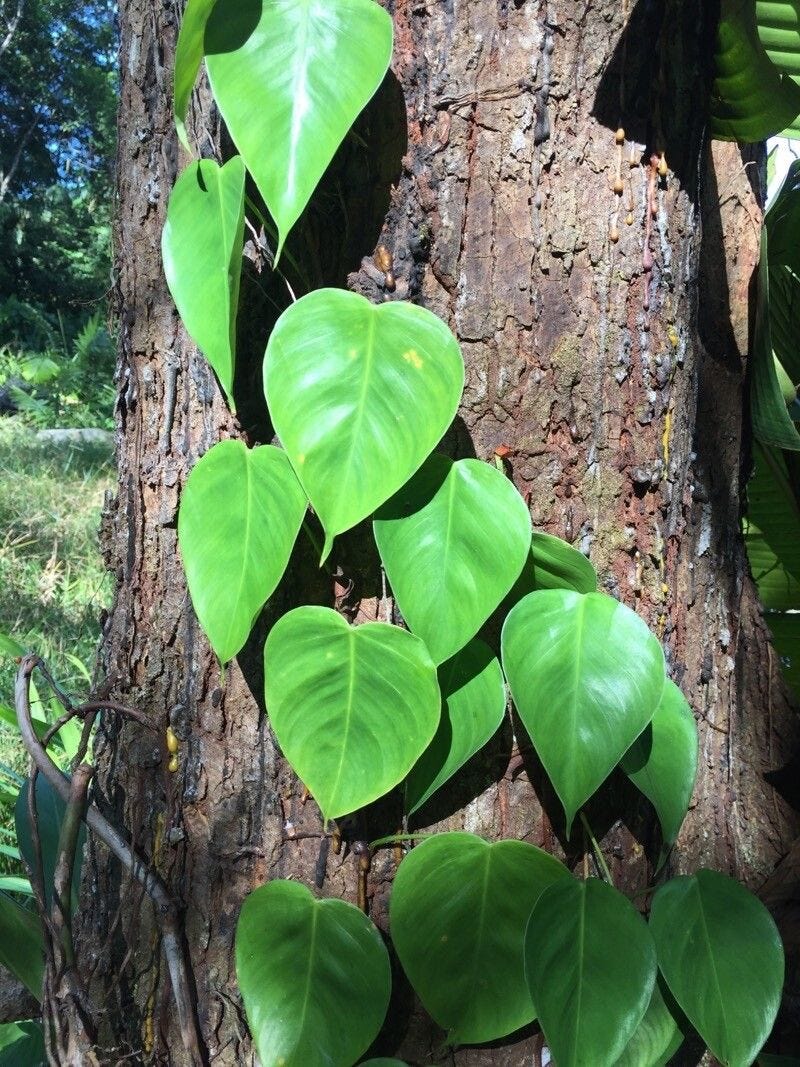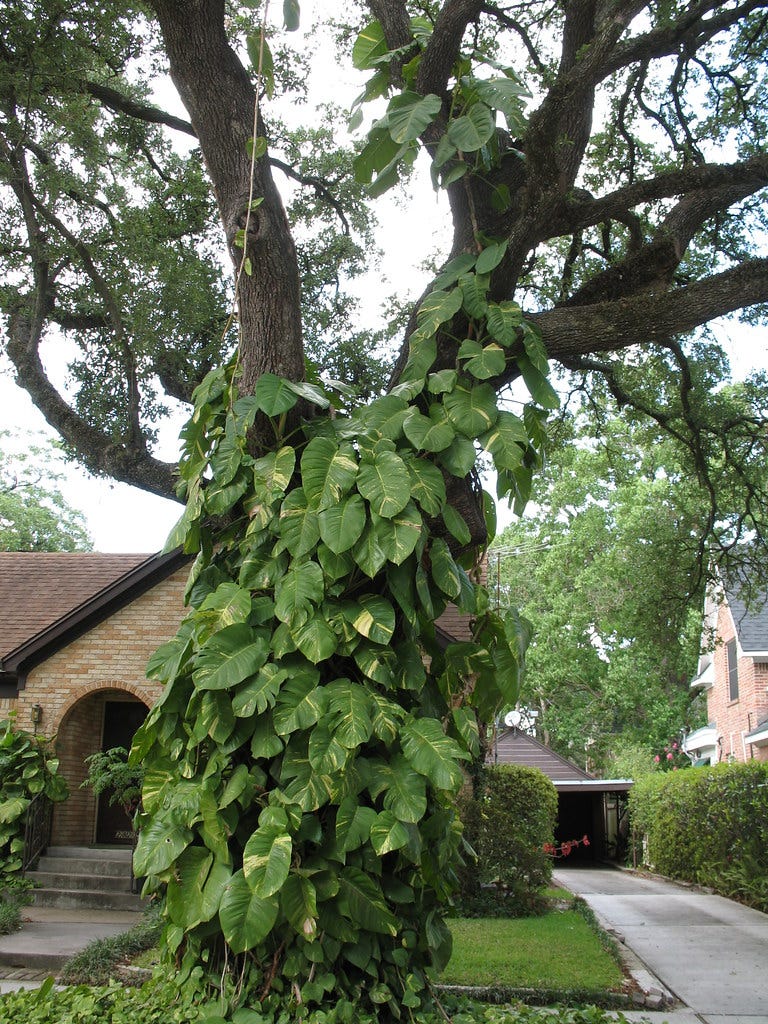ALSO KNOWN AS: Epipremnum aureum, Devil’s Ivy, hunter’s rove, taro vine, money plant, jade pothos, marble queen, previously: Pothos aureus and Scindapsus aureus
Not philodendron. They look almost exactly the same but philodendron has these little brown parts of the stem (cataphyll) that dry and fall off when each new leaf grows. So random.
Or Irish ivy, though it has heart shaped leaves when it’s young.
How to know:
Waxed evergreen
White swaths along their leaves
Fibrous vines with brown nodes and roots that hang down, or grasp onto trees.
If it’s not in a tree its one massive sheet of green on the ground
Many of us know pothos. If we don’t have one ourselves we have seen it. It’s the one with long vines and waxen heart shaped leaves, possibly splattered with some white or cream. You see them situated in offices or establishments, pressed against windows of apartments where you hope they are remembered. But they grow despite neglect. There are a few varieties of this plant, but the most common is the golden pothos and it’s truly an everyman’s plant. Sometimes I wonder if our cities have more pothos than grass: that there’s more greenery in the form of pothos in our indoor spaces than there are on the streets.
But golden pothos is not, in fact, so common. It has some of the rarest characteristics of any plant we know. Golden pothos is endemic to Mo’orea, an island in French Polynesia, close to Tahiti. In its native habitat it climbs up trees and covers the ground in swaths of green. And, has one of the most rare flowers of any plant.
These pothos on our ledges and windows will never reach maturity. Your pothos will never flower.
So, despite many people’s familiarity with the leaves and vines, the flowers are the pothos’ secret. They come peek out of the vines like a lily with a deep cream hood, or spathe that holds the spadix or pollen head. These flowers produce a small heat that warm their pollenating beetles. When fully bloomed it looks like a corn cob spattered in purple. One number is that there hasn’t been a pothos bloom in the wild in sixty years. They are missing, or very low on a key growth hormone called gibberellins that signals a plant to flower. While scientists can coax a pothos to flower scientists don’t entirely understand why they have adapted to not flower in the wild.
Which means the pothos that you have might be the very same pothos that I have, which might be the pothos in the West Palm beach airport. This also means there are no hybrids of pothos. The only way this plant is changed is by exposing a new bud to a stress this process of selection will slowly change its DNA. There are 15 types of pothos, but they are so common that they are often confused with other houseplants, like philodendron, or even a juvenile monstera.
The golden pothos has successfully adapted to not need to flower. Without pollination, it grows easily 40 feet up trees at a rate of around 18 inches per month in warm seasons. Their vines harden into woody coils. Two foot long leaves the shape of tear drops obscure the trunks of trees. Indoor plants have long club-like roots hang that down from its web in the window, endlessly looking for soil. They grow so fast we can almost see them twisting as they strive toward the canopy they have adapted to find. But in the low light of tiny apartments these plants grow where many other plants would not. This is why they’re known as devil’s ivy: green even in darkness, vivacious and nearly impossible to kill, pushed by a seemingly demonic or supernatural force. They grow with a nearly spiteful gusto.
Pothos behaves invasively on several tropical islands in Southeast Asia in Southern India, and Sri Lanka because of how quickly they grow and how easily they propagate when broken. They have been naturalized in some areas of Africa and the Carribean, however, and can be seen all around the world. For a species that hardly ever flowers this is an impressive feat. But in cooler climates they are invasive without being an invasive species. They are everywhere, behaving aggressively in confined quarters where other plants would be found dead.
The Araceae family of golden pothos include the cala lily, the taro, and duck weed. Many share the hooded flower head and that signature heart shaped leaf.
The golden pothos has had several names. The term pothos isn’t technically accurate. They were first described in the 1800s as “Pothos aureus” because they were believed to be similar to the pothos repens, a crawling plant with red berries in the Pothoideae subfamily. But plants are classified, in many ways, on their form of flower. And this one had such a latent flower, western forms of naming didn’t get to it until it was found flowering in 1962, when it was named Rhaphidophora aurea, then Epipremnum pinnatum. Since then it has settled onto Epipremnum areum, a Latin name roughly meaning “gold in the trees”. This confusion could be a reflection on the western practices of naming plants people don’t have a cultural/ancestral relationship with, or it could be indicative of the similarities of these varieties of species.
Having come of age in New York City, I have had my share of roommates - and houseplants. I spent a lot of time worrying about and then overwatering plants, just like I spent worrying about how to better accommodate this or that roommate. Sometimes they were strangers from the internet. Sometimes I was the stranger. Sometimes they were friends of mine. Sometimes they began as friends and became roommates. Living with people can produce eerie alchemies of connection. Only one of them gifted me a pothos.
We lived in a basement apartment in Greenpoint. She was an artist and a framer and she gave me a cutting with two leaves in a glass of water. I kept it in the bathroom because that’s where we had most of our light. It took less than a week for it to grow roots. It can grow indefinitely without soil. But I potted it once the pearly roots spiraled around the inside of the glass. Ten years later that same plant is split up into five separate plants, and is growing all over the bedroom window. It has been been regifted. In many ways pothos gave me the confidence to take care for and see the dynamism in plants. It grows quickly and dies slowly so that we can even receive feedback from it.
In my imagination, when the end comes and most humans are gone pothos will become invasive for a while. For now they are secretly building their numbers and resistance to cold in our windows.
Pothos has been adopted as a houseplant mostly as a filter for indoor pollutants such as removing indoor pollutants such as formaldehyde, xylene, and benzene. It has calcium oxalates, tiny crystals that can’t be digested, and if the sap is handled too much it can cause irritation. So pothos is mildly toxic for humans and animals to ingest. While inedible as a food, they can be used medicinally for a range of treatments. In Malaysia golden pothos has been used as an anti cancerous agent, and to treat skin diseases. Medicine from golden pothos is also believed to be anti diabetic and wound healing. Of course as a living vine, pothos can be trained as a curtain or wall of leaves. There are volumes of ethnobotanical facts left unsaid here, that I wish I could learn about. But I bet it can weave. I bet it can become a textile.
Myth for golden pothos
A demon lived in the forests of a volcanic island loved shiny things. He especially loved lava, so when the volcano erupted on the island he would dance and dance around the mountain. He would bathe in the lava. He would sing to the fire. He would collect the lava and bring it home in the caves where it was warm enough so that it would never harden.
But a time came when the volcano grew tired of erupting every year. So the rare times when it erupted became sacred to him. And after every eruption he would make new gardens and they would grow bigger and more beautiful with each eruption because he was that much happier to see the lava flow. But as the volcano grew more and more tired and erupted less and less he decided to go into the earth to bring the fire up himself. So this is what he did.
Meanwhile, the mountain grew angry that the demon could not wait. Demons live forever, this could wait ten thousand years for the mountain to rest. So the mountain turned all the demon’s hoarded lava into plants and turned the demon into its roots, so that he was always reaching up, reaching up for the gold in the leaves. “Once you have flowered ten thousand times you will be able to come back to the mountains and I will have woken up again.” The mountain said. That’s why pothos grow so fast. It’s always reaching up the mountain it is never able to reach the gold it seeks. Each flower that bloom is warm with lava in the plant’s veins. And all the while the demon must wait for decades for each flower to bloom and it gets that much closer to the waking of the mountain.
Forager Friendly?
Take a cutting, put it in water. Yes, forage this plant, not to eat, but to grow.
Sources:
https://www.indefenseofplants.com/blog/2018/1/9/this-isnt-even-my-final-form
https://en.wikipedia.org/wiki/Epipremnum_aureum
https://plants.ces.ncsu.edu/plants/epipremnum-aureum/
https://www.almanac.com/plant/pothos
https://nerdfighteria.info/v/M3UsOJPEpfs/
https://hort.extension.wisc.edu/articles/pothos-epipremmum-aureum/







